
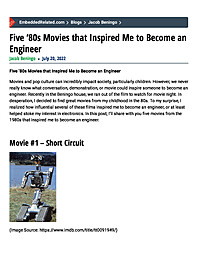
Five ‘80s Movies that Inspired Me to Become an Engineer
Five ‘80s Movies that Inspired Me to Become an EngineerMovies and pop culture can incredibly impact society, particularly children. However, we never really know what conversation, demonstration, or movie could inspire someone to become an...
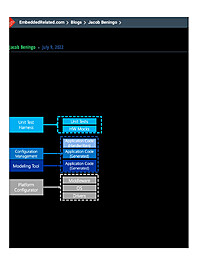
3 Overlooked Embedded Software Elements
Have you ever wondered, while you and your team are busy writing software if the foundation of how embedded software systems are built has changed and left you in the dust? What if while you were busily focusing on getting your product out the...
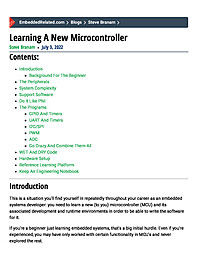
Learning A New Microcontroller
Contents: Introduction Background For The Beginner The Peripherals System Complexity Support Software Do It Like Phil The Programs GPIO And Timers UART And Timers I2C/SPI PWM ADC Go Crazy And Combine Them All WET And DRY...
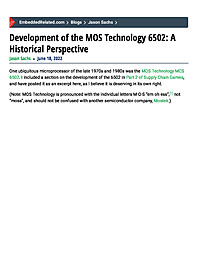
Development of the MOS Technology 6502: A Historical Perspective
One ubiquitous microprocessor of the late 1970s and 1980s was the MOS Technology MCS 6502. I included a section on the development of the 6502 in Part 2 of Supply Chain Games, and have posted it as an excerpt here, as I believe it is deserving...
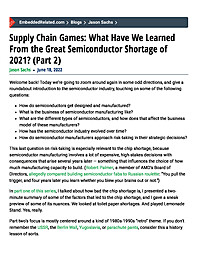
Supply Chain Games: What Have We Learned From the Great Semiconductor Shortage of 2021? (Part 2)
Welcome back! Today we’re going to zoom around again in some odd directions, and give a roundabout introduction to the semiconductor industry, touching on some of the following questions: How do semiconductors get designed and...
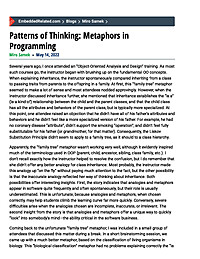
Patterns of Thinking: Metaphors in Programming
Several years ago, I once attended an “Object-Oriented Analysis and Design” training. As most such courses go, the instructor began with brushing up on the fundamental OO concepts. When explaining inheritance, the instructor spontaneously...

Reading and Understanding Profitability Metrics from Financial Statements
Whoa! That has got to be the most serious-minded title I’ve ever written. Profitability Metrics from Financial Statements, indeed. I’m still writing Part 2 of my Supply Chain Games article, and I was about to mention something about...
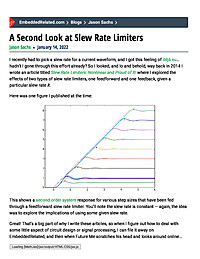
A Second Look at Slew Rate Limiters
I recently had to pick a slew rate for a current waveform, and I got this feeling of déjà vu… hadn’t I gone through this effort already? So I looked, and lo and behold, way back in 2014 I wrote an article titled Slew Rate...

Supply Chain Games: What Have We Learned From the Great Semiconductor Shortage of 2021? (Part 1)
So by now I’m sure you’ve heard about the semiconductor shortage of 2021. For a few complicated reasons, demand is greater than supply, and not everybody who wants to buy integrated circuits can do so. Today we’re going to try...
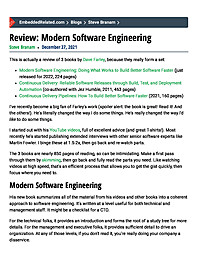
Review: Modern Software Engineering
This is actually a review of 3 books by Dave Farley, because they really form a set: Modern Software Engineering: Doing What Works to Build Better Software Faster (just released for 2022, 224 pages) Continuous Delivery: Reliable...
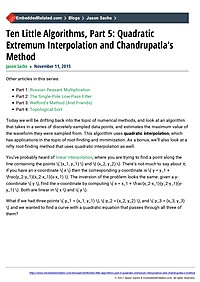
Ten Little Algorithms, Part 5: Quadratic Extremum Interpolation and Chandrupatla's Method
Today we will be drifting back into the topic of numerical methods, and look at an algorithm that takes in a series of discretely-sampled data points, and estimates the maximum value of the waveform they were sampled from.
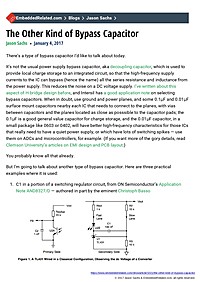
The Other Kind of Bypass Capacitor
There’s a type of bypass capacitor I’d like to talk about today. It’s not the usual power supply bypass capacitor, aka decoupling capacitor, which is used to provide local charge storage to an integrated circuit, so that the...
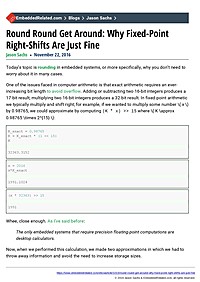
Round Round Get Around: Why Fixed-Point Right-Shifts Are Just Fine
Today’s topic is rounding in embedded systems, or more specifically, why you don’t need to worry about it in many cases.One of the issues faced in computer arithmetic is that exact arithmetic requires an ever-increasing bit length to...
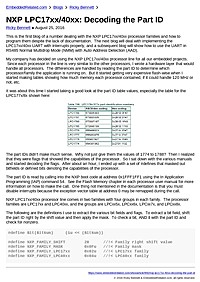
NXP LPC17xx/40xx: Decoding the Part ID
This is the first blog of a number dealing with the NXP LPC17xx/40xx processor families and how to program them despite the lack of documentation. The next blog will deal with implementing the LPC17xx/40xx UART with interrupts...
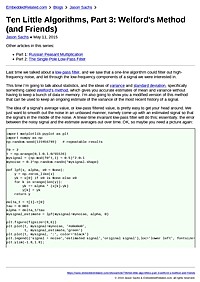
Ten Little Algorithms, Part 3: Welford's Method (and Friends)
Other articles in this series: Part 1: Russian Peasant Multiplication Part 2: The Single-Pole Low-Pass Filter Last time we talked about a low-pass filter, and we saw that a one-line algorithm could filter out high-frequency noise, and...
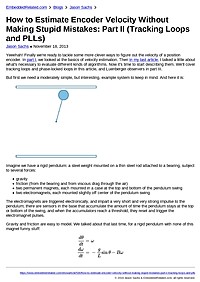
How to Estimate Encoder Velocity Without Making Stupid Mistakes: Part II (Tracking Loops and PLLs)
Yeeehah! Finally we're ready to tackle some more clever ways to figure out the velocity of a position encoder. In part I, we looked at the basics of velocity estimation. Then in my last article, I talked a little about what's necessary to...
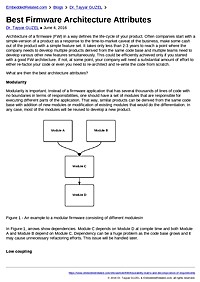
Best Firmware Architecture Attributes
Architecture of a firmware (FW) in a way defines the life-cycle of your product. Often companies start with a simple-version of a product as a response to the time-to-market caveat of the business, make some cash out...

Analog-to-Digital Confusion: Pitfalls of Driving an ADC
Imagine the following scenario:You're a successful engineer (sounds nice, doesn't it!) working on a project with three or four circuit boards. More than even you can handle, so you give one of them over to your coworker Wayne to design....
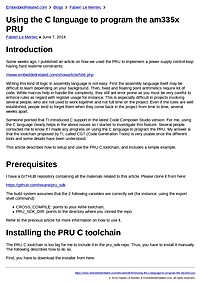
Using the C language to program the am335x PRU
Introduction Some weeks ago, I published an article on how we used the PRU to implement a power supply control loop having hard realtime constraints: http://www.embeddedrelated.com/showarticle/586.php Writing this kind of logic in assembly...
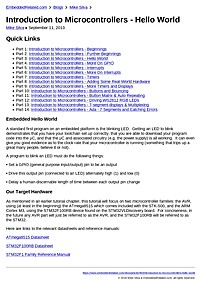
Introduction to Microcontrollers - Hello World
[quicklinks] Embedded Hello World A standard first program on an embedded platform is the blinking LED. Getting an LED to blink demonstrates that you have your toolchain set up correctly, that you are able to download your program...



















